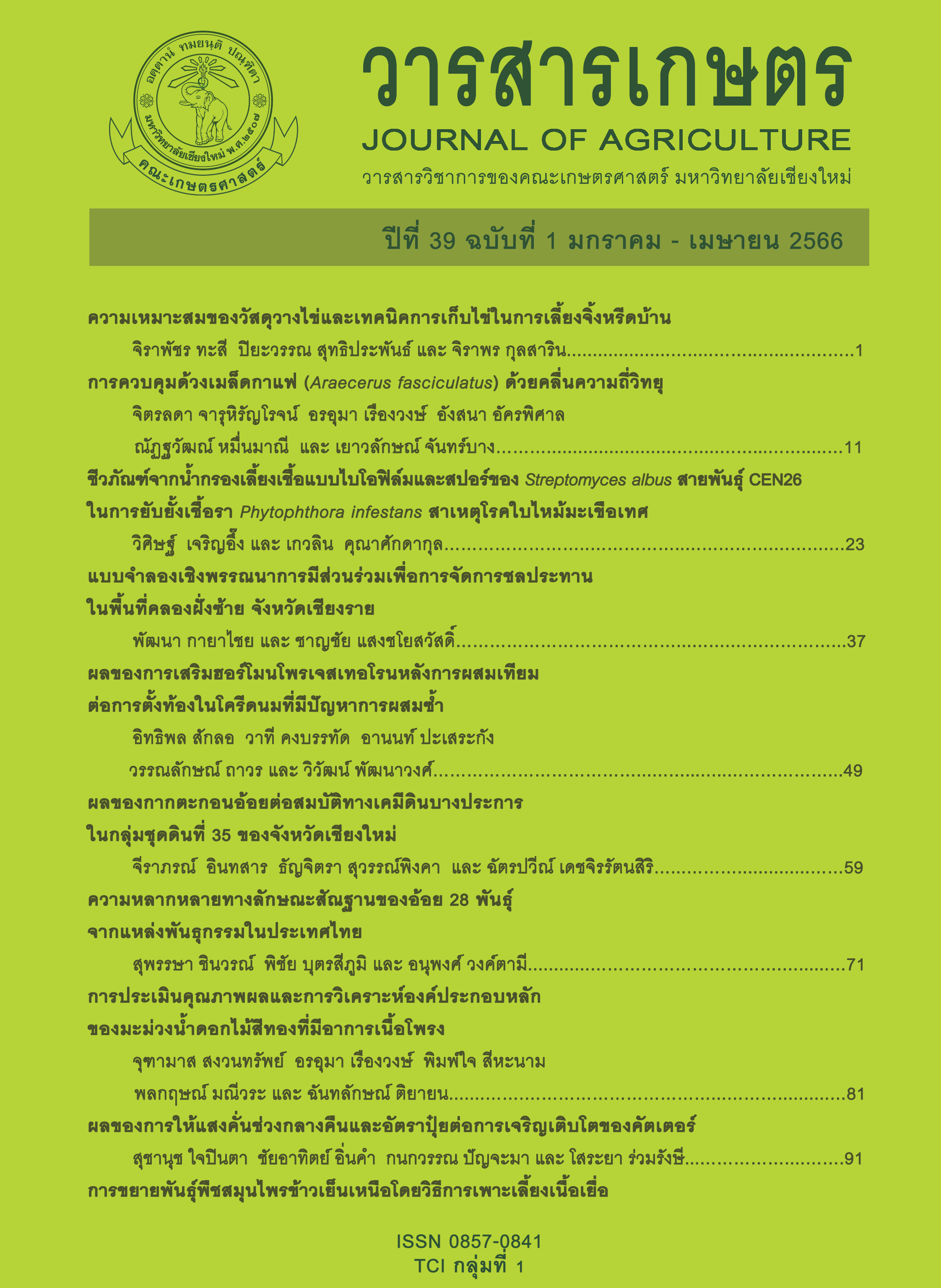Bioproducts from Biofilm Culture Filtrate and Spore of <I>Streptomyces albus</I> Strain CEN26 Against <I> Phytophthora infestans</I> Causing Tomato Late Blight
Main Article Content
Abstract
The efficacy of biofilm culture filtrate from Streptomyces albus strain CEN26 to control late blight pathogen, Phytophthora infestans was investigated. Inhibition of P. infestans, mycelial growth, germination and viability of the sporangia were evaluated and found that the minimum concentration of the filtrate at 60 % effectively 100 % inhibited the fungus. The filtrate concentration at 40 % resulted in significant inhibition of the fungal mycelial growth and sporangia viability at lower rates than the 60 % trials, though, it’s still extremely inhibited the sporangia germination in all incubation period trials. Even though, the concentration at 20 % had no effect on sporangia viability but clearly restrained its germination period. The disease control trial in greenhouse condition using bioproducts produced from biofilm culture filtrate combined with dry spore of S. albus strain CEN26 showed reductions in both percentages of disease incidence and severity index better than the trial of bioproduct produced from only the dry spore. Then, bioproduct produced from biofilm culture filtrate combined with the dry spore was selected to apply in farmer plot trial, by spraying 0.3 g/l once a week for 4 months, the disease reduction was found with percent of disease incidence and severity index revealed at 25.45 % and 45.63 %, while the untreated farmer plot was determined at 52.30 % and 75.45 %, respectively.
Article Details

This work is licensed under a Creative Commons Attribution-NonCommercial-NoDerivatives 4.0 International License.
References
Abbasi, S., A., Spor, A. Sadeghi and N. Safaie. 2021. Streptomyces strains modulate dynamics of soil bacterial communities and their efficacy in disease suppression caused by Phytophthora capsici. Scientific Reports 11: 9317, doi: 1.1038/S41598-021-88495-y.
Brent, K.J. and D.W. Hollomon. 1995. Fungicide resistance in crop pathogens: How can it be managed? (Online). Available: https://www.frac.info/docs/default-source/publications/monographs/monograph-1.pdf (December 31, 2021).
Costa, L.C.B., J.E.B.P. Pinto, S.K.V. Bertolucci, J.C.D.B. Costa, P.B. Alves and E.D.S Niculau. 2015. In vitro antifungal activity of Ocimum selloi essential oil and methylchavicol against phytopathogenic fungi. Revista Ciencia Agronomica 46(2): 428-435.
FAO. 2017. The future of food and agriculture: Trends and challenges. (Online). Available: http://www.fao.org/3/i6583e/i6583e.pdf (December 20, 2021).
Glendinning, D., J.A. Macdonald and J. Grainger. 1963. Factors affecting the germination of sporangia in Phytophthora infestans. Transactions of the British Mycological Society 46(4): 595-603.
Igarashi, Y., M. Ogawa, Y. Sato, N. Saito, R. Yoshida, H. Kunoh, H. Onaka and T. Furumai. 2000. Fistupyrone, a novel inhibitor of the infection of Chinese cabbage by Alternaria brassicicola, from Streptomyces sp. TP-A0569. The Journal of Antibiotics 53(10): 1117-1122.
Kavitha, A., M. Vijayalakshmi, P. Sudhakar and G. Narasimha. 2010. Screening of actinomycetes strains for the production of antifungal metabolites. African Journal of Microbiology Research 4(1): 27-32.
Kunasakdakul, K. and S. Chaichom. 2018. Research and development of bioproducts against gray mold of roses. Final Report. Highland Research and Development Institute (Public Organization), Chiang Mai. 50 p. (in Thai)
Kunasakdakul, K., W. Jaroenueng, J. Chanthawong and P. Thayaping. 2021. Development of soluble powder bio-pesticide from Streptomyces sp. for control leaf diseases of solanaceous plant. Final Report. Royal Project Foundation, Chiang Mai. 110 p. (in Thai)
Larkin, P.J. 1976. Purification and viability determinations of plant protoplasts. Planta 128(3): 213-216.
Manteca, A., R. Alvarez, N. Salazar, P. Yague and J. Sanchez. 2008. Mycelium differentiation and antibiotic production in submerged cultures of Streptomyces coelicolor. Applied and Environmental Microbiology 74(12): 3877-3886.
Markets and Markets. 2021. Biofungicides market by type (microbial species, botanical), mode of application (soil treatment, foliar application, seed treatment), species (Bacillus, Trichoderma, Streptomyces, Pseudomonas), crop type, formulation, and region - Global forecast to 2025. (Online). Available: https://www.marketsandmarkets.com/Market-Reports/biofungicide-market-8734417.html (December 20, 2021).
McMaugh, T. 2005. Guidelines for Surveillance Plant Pests in Asia and the Pacific. ACIAR Monograph No. 119, Australia. 192 p.
Nelson, S.C. 2008. Late blight of tomato (Phytophthora infestans). (Online). Available: https://www.ctahr.hawaii.edu/oc/freepubs/pdf/PD-45.pdf (December 31, 2021).
Phuakjaiphaeo, C., C.I. Chang, O. Ruangwong and K. Kunasakdakul. 2016. Isolation and identification of an antifungal compound from endophytic Streptomyces sp. CEN26 active against Alternaria brassicicola. Letters in Applied Microbiology 63(1): 38-44.
Phuakjaiphaeo, C. 2017. Selection of endophytic actinomycetes and evaluation of their antifungal compounds for controlling Alternaria leaf spot of cabbage. Ph.D. Thesis. Chiang Mai University, Chiang Mai. 169 p.
Sellem, I., M.A. Triki, L. Elleuch, M. Cheffi, A. Chakchouk, S. Smaoui and L. Mellouli. 2017. The use of newly isolated Streptomyces strain TN258 as potential biocontrol agent of potato tubers leak caused by Pythium ultimum. Journal of Basic Microbiology 57(5): 393-401.
Shimizu, M, Y. Nakagawa, Y. Sato, T. Furumai, Y. Igarashi, H. Onaka, R. Yoshida and H. Kunoh. 2000. Studies on endophytic actinomycetes (I) Streptomyces sp. isolated from Rhododendron and its antifungal activity. Journal of General Plant Pathology 66: 360-366.
Taechowisan, T., S. Chanaphat, W. Ruensamran and W.S. Phutdhawong. 2012. Antifungal activity of 3- methylcarbazoles from Streptomyces sp. LJK109; an endophyte in Alpinia galanga. Journal of Applied Pharmaceutical Science 2(3): 124-128.
Tumwine, J., H.D. Frinking and M.J. Jeger. 2000. Isolation techniques and cultural media for Phytophthora infestans from tomatoes. Mycologist 14(3): 137-139.
Waller, J.M., J.M. Lenne and S.J. Waller. 2002. Plant Pathologist’s Pocketbook. 3rd ed. CABI Publishing, Wallingford. 516 p.
Winter, M., P.L. Samuels, L.K. Otto-Hanson, R. Dill-Macky and L.L. Kinkel. 2019. Biological control of Fusarium crown and root rot of wheat by Streptomyces isolates - it’s complicated. Phytobiomes Journal 3(1): 52-60.
Yague, P., M.T. Lopez-Garcia, B. Rioseras, J. Sanchez and A. Manteca. 2012. New insights on the development of Streptomyces and their relationships with secondary metabolite production. Current Trends in Microbiology 8: 65-73.


